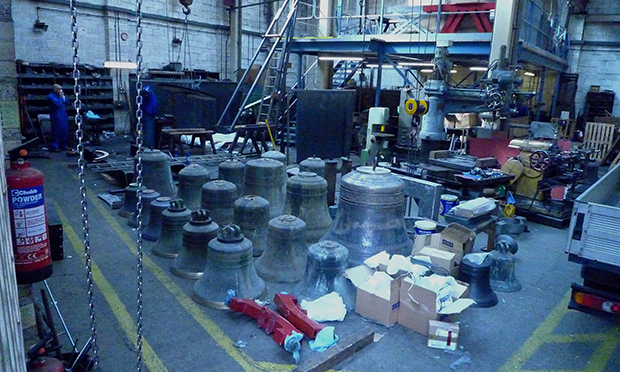Bells still tolling at Whitechapel foundry
The Whitechapel Road originated as a Roman highway – a direct route from the City of London to Colchester. As centuries have come and gone the road has now completely changed, but for more than 400 years now there has been one constant: the Whitechapel Bell Foundry.
Established in 1570 during the reign of Elizabeth I, the elegant wooden Georgian facade of the grade II listed Whitechapel Bell Foundry still graces the busy thoroughfare. Most importantly, the facade in question belongs to the UK’s oldest manufacturing company. To this day bells tolling across the world are being cast in Whitechapel.
The entrance brings you into a heavily decorated reception room full of old photographs and memorabilia – some highlighting royal visits, others commemorating specific anniversaries. The unbroken line of master bell founders stretching back to 1420 is also proudly exhibited, as is the wooden template used when manufacturing Big Ben.
There is no doubt the factory’s main claim to fame is the production of the almighty 13.5 ton Big Ben in 1858 (Big Ben is, of course, the name of the bell – not the tower). But the roll-call extends much further than that.
The Liberty Bell (symbol of American freedom), the Bells of St Clement Danes (of ‘Oranges & Lemons’ nursery rhyme fame), Bow Bells (which chime from the belfry of Saint Mary-le-Bow on Cheapside in the City rather than from Bow Church, as is commonly assumed) were all cast there as well. As were the clock bell at St Paul’s Cathedral, the octave at Winchester Cathedral, the hour bell at Canterbury Cathedral, the Great Bell of Montreal, the Bicentennial Bell…
Moving on into the back room a short video can be watched explaining the manufacturing of a bell from beginning to end. The process is complex, but it interesting to note that despite technological progress, the fundamentals of bell founding remain the same as they were in medieval times: molten metal is poured in to a bell-shaped mould, which is then opened once the metal has cooled. The fine-tuning which follows has evolved, but the basics remain unchanged.
Adjacent to this room is an outdoor courtyard with bells scattered across it. At the far end the lead water tank dating back to the building’s days as the Artichoke Inn still stands. I am informed that some of the bells out there are destined for Brazilian and American shores.
On a hot summer day the shutter doors on Plumbers Row are sometimes opened and offer a glimpse into a world which is very different to what many of us have grown accustomed to. Here you might find master founders Alan and Kathryn Hughes (whose family have been founding bells in East London since 1884) and members of their team hard at work casting glistening bells in what is otherwise a dreary workshop. Rows of variously-sized bells line the floor – church bells, hand bells, ship bells, level crossing warning bells – and are surrounded by all the machines required for tuning, moulding, drilling, skirting, testing, fitting and fashioning. It’s quite a site.
Meanwhile, just down the street in the City of London, thousands are crunching numbers, analyzing spreadsheets, and typing away on their computers. The contrast between the rustic workshop and the shiny glass towers could hardly be more pronounced.
It is remarkable to think that across the street from HSBC bank, a few doors down from the Rhythm Factory music venue and the Tesco supermarket, there remains a factory of such historical significance that has been specialising in such a unique craft for over four centuries.
“Our business runs counter to the national economy” Alan Hughes explained to the Gentle Author blog. The reason for this, he says, is that “bell projects take a long time, so churches commit to new bells when the economy is strong and then there is no turning back.”
Apparently it takes at least 10 years between order and delivery. This has consequently enabled the foundry to have a continuous work flow throughout the good times and the bad.
Whitechapel Road has changed time and again, and the upcoming opening of the new Crossrail station is likely to ensure that another wave of change sweeps through the area. It’s safe to say, however, that the Whitechapel Bell Foundry can probably handle whatever comes its way, just as its bells have done year after year.

